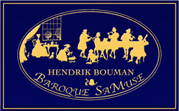*

fingers play the natural keys at their very front, as taught in great detail by Thomas di Santa Maria in the XVIth C. The physical keys for the accidentals approach each other often so much laterally, especially the cluster of three, the F sharp, G sharp and B flat, that no finger can access the in between lying area of the naturals G and A. Keyboard music of this period and throughout the XVIIth C is written in simple tonalities, and is generally based on the naturals.
Likewise, we see that tuning and temperament was primarily based on the naturals, whereby the accidentals were seen only in their relation to the naturals and not to each other. Many historic tuning instructions deal with the natural keys first, after which the accidentals are positioned in relation to those naturals and not to each other.
Meantone temperament, as proposed by Aron in the early XVIth C, is a keyboard temperament that clearly favours the purity of the major thirds over the purity of the fifths. In fact, in its pure form, meantone temperament reduces all fifths by one quarter of a Pythagorean comma except for one unusable fifth (the “wolf)” which beats upwards (i.e. seven commas too large!). Two-thirds of all its major thirds are pure whereas all other thirds basically unusable. One could say that meantone is an equal temperament because its usable fifths are reduced in equal measure, its usable thirds equally pure and its unusable thirds (one out of three) equally augmented. However, compared to modern equal temperament, meantone as a system, is non-circular: the circle of fifths is interrupted at one place. To the modern uninitiated listener it may seem surprising that one could bear with a meantone fifth that creates a noticeable beating because of the interference of the two frequences that compose the interval. But then again, for people of the baroque era it was the still greater restlessness of an equal tempered major third that was perceived as being out of tune and therefore unnatural. As the perception of a tempered chord reflects the sum of all beatings, we have to conclude that a major triad in meantone, having less beatings over all, requires less tolerance than the same triad in equal temperament. Even when the meantone temperament was largely abandoned during the first half of ther 18thC, the meantone value of the fifth still persisted as an element in the new temperaments.
It was a difficult step toward the end of the XVIIth C, not from an ideological point of view but from the point of hearing tolerance, to move towards a modified meantone system in which certain accidentals could be used for enharmonic purposes - the E-flat as D-sharp, the G sharp as A-flat (notes for which on some keyboards double accidentals were introduced), and in lesser degree the B-flat as A-sharp. Such a modification to the pitch of G-sharp, for instance, would necessarily increase the beatings within the E-major triad, in which it constitutes the major third, and therefore create an impression of greater out-of-tuneness. In order to out-balance this negative effect within one triad, by allowing the major third to be sharper, the fifth must be purer. This measure is at the essence of the well-temperaments proposed during Bach’s time such of Werckmeister’s, shortly before 1700. These new temperaments are fully circular but highly unequal, that is, irregular.
The ingeniously crafted new temperaments of the late baroque are not the product of abstract calculation, but respect as much as possible the still dominating hierarchy of tonalities while allowing other more remote ones to be included. The more remote the tonalitiy, the sharper its major thirds, but ironically, in the simpler tonalities with few sharps or flats the fifths are worst (yet equal to meantone ones), whereas between most of the accidentals the fifths are kept pure.
When at this time the necessity is felt to venture into more remote tonalities and to set for instance a composition in E flat major, or to modulate temporarily to f-sharp major, then there is not only a fitting temperament available but also the accomodating keyboard with the longer keys and the slimmer accidentals (in between which the fingers do not get stuck!), a development particularly noticeable in Germany. If then the tuning characteristics of such a composition or passage are distinct from a composition in C major than this is no surprise to the contemporary knowledgable listener who is familiar with the tone colour changes which arise drastically when a traverso or string instruments move into tonalities with many flats or sharps, away from their ‘home territory’. The baroque era acknowledges inequality as an essence of life and it is up to us to respect this enriching element when dealing with its musical heritage.
©Hendrik BOUMAN, Nice France 2014
We recall that keyboard temperament is an inevitability because of the incompatibility of octaves, fifths and major thirds if we insist on their absolute purity (which concords when the simple physical proportions of these intervals are being respected, eg: a frequency difference of 1:2 gives an octave, 2:3 gives a fifth etc.).
Firstly twelve fifths mounted on top of each other result in a note which is one Pythagorean comma higher than the same note obtained by piling up seven octaves; secondly the sum of four fifths produce two octaves plus a major third which is the same Pythagorean comma too high (or sharp); and thirdly the sum of three major thirds ends up one syntonic comma underneath one octave.
Particular to a keyboard is that the pitch for each key is fixed, and the rigid nature of keyboards in this respect requires an unambivalent tuning system. There is no way around it: for any keyboard tuning the purity of certain intervals is by definition, compromised. The design of these compromises between the different keys is called temperament and is an esthetic choice which varied in function of period, region and social-cultural context.
We do encounter fixations of temperament on other historical instruments as well, such as wind instruments, but these instruments differ from keyboard instruments on three important points: one can apply different fingerings for enharmonic “identities”, making a distinction between a G sharp and a A flat for instance; one can through blowing techniques modify the pitch of one and the same note in function of its most prominent role in the harmonic context, for example an F sharp may require a different intonation as a fifth in a B minor chord, than as a major third in a D major chord; thirdly, because of their linear and non-chordic character, there is no necessity to submit such instruments to a closed system which defines each and every note within the circle of fifths.
It speaks for itself that the human voice has full liberty in intonation to opt for the optimal results. Thereby should be remarked that what we like to consider intuitively as just intonation is largely influenced by our hearing habits. At present, because of the generally adopted equal temperament, our ear has become accustomed to major thirds which are sharp i.e. larger than pure, and for the unaccustomed ear the confrontation with a “just”, pure or “still “major third forms initially a surprise, sometimes to the extent that a modern trained musician can perceive the pure major third as being squarely wrong.
It is documented that in the XVIIIth C such compromised major thirds in instrumental and vocal solos were to be avoided (Agricola/Tosi). One was very much aware that the new temperaments, proposed around the turn of the century to create more versatility in the use of the keyboard, produced sharp major thirds that should not necessarily be imitated literally within the surrounding ensemble. Also the drilling of the finger holes in the wind instruments of that period continued to respect low sharps and high flats necessary to obtain perfect major thirds. By the middle of the century, Quantz in his flute treatise quotes an enharmonic change in a work by Friedemann Bach where slightly different pitches are to played by using two different fingerings.
To understand historical keyboard temperament and its evolution, we have to look at the lay-out of the keyboard. There is a visible hierarchy between the naturals and the accidentals; also our note names A B C or DO Ré MI indicate the naturals only. An accidental serves as a derivation of its root note, originally just as a “colouring” a notion that we find back in the term chromatics. In this respect there is a similarity with other instrument types, which are without exception based on one of the “natural” tonalities, C, D, G or F.
As music of the Renaissance adheres throughout to its age-old ‘solmisation’ system, all such music transcribed or adapted for keyboard can be brought back to a tonality with none or few accidentals. The handful of tonalities used in musical composition for the keyboard in the XVIIth C appears restricted from a modern viewpoint, but for a musician of those days to base a piece on a tonality which is an accidental itself, such as A flat major, would be a useless excercise. Even when the theme of the Romanesca Variations by Frescobaldi seem to form an exception by starting in B flat major, the piece immediately moves to G minor and ends with a G major chord; The shape of the keyboard was conceived perfectly ergonomical for its usage. The short key length and its frequently close pivoting point are coherent with contemporary playing technique in which the

HENDRIK BOUMAN
Keyboard temperament




